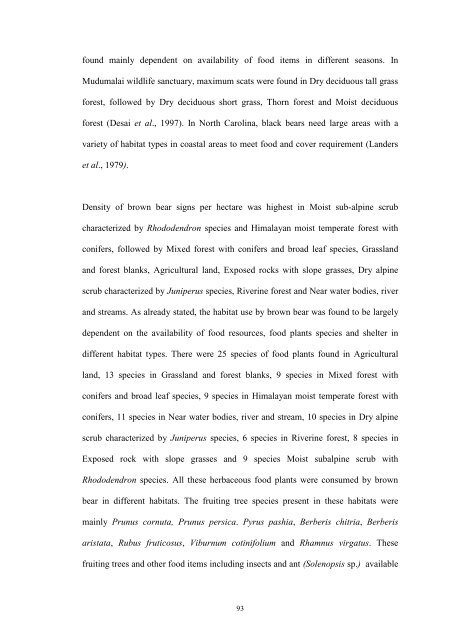Certificate - Etheses - Saurashtra University
Certificate - Etheses - Saurashtra University
Certificate - Etheses - Saurashtra University
You also want an ePaper? Increase the reach of your titles
YUMPU automatically turns print PDFs into web optimized ePapers that Google loves.
found mainly dependent on availability of food items in different seasons. In<br />
Mudumalai wildlife sanctuary, maximum scats were found in Dry deciduous tall grass<br />
forest, followed by Dry deciduous short grass, Thorn forest and Moist deciduous<br />
forest (Desai et al., 1997). In North Carolina, black bears need large areas with a<br />
variety of habitat types in coastal areas to meet food and cover requirement (Landers<br />
et al., 1979).<br />
Density of brown bear signs per hectare was highest in Moist sub-alpine scrub<br />
characterized by Rhododendron species and Himalayan moist temperate forest with<br />
conifers, followed by Mixed forest with conifers and broad leaf species, Grassland<br />
and forest blanks, Agricultural land, Exposed rocks with slope grasses, Dry alpine<br />
scrub characterized by Juniperus species, Riverine forest and Near water bodies, river<br />
and streams. As already stated, the habitat use by brown bear was found to be largely<br />
dependent on the availability of food resources, food plants species and shelter in<br />
different habitat types. There were 25 species of food plants found in Agricultural<br />
land, 13 species in Grassland and forest blanks, 9 species in Mixed forest with<br />
conifers and broad leaf species, 9 species in Himalayan moist temperate forest with<br />
conifers, 11 species in Near water bodies, river and stream, 10 species in Dry alpine<br />
scrub characterized by Juniperus species, 6 species in Riverine forest, 8 species in<br />
Exposed rock with slope grasses and 9 species Moist subalpine scrub with<br />
Rhododendron species. All these herbaceous food plants were consumed by brown<br />
bear in different habitats. The fruiting tree species present in these habitats were<br />
mainly Prunus cornuta, Prunus persica. Pyrus pashia, Berberis chitria, Berberis<br />
aristata, Rubus fruticosus, Viburnum cotinifolium and Rhamnus virgatus. These<br />
fruiting trees and other food items including insects and ant (Solenopsis sp.) available<br />
93

















